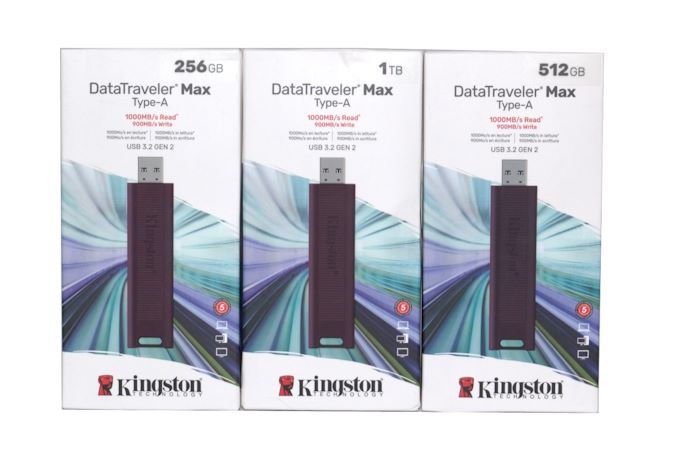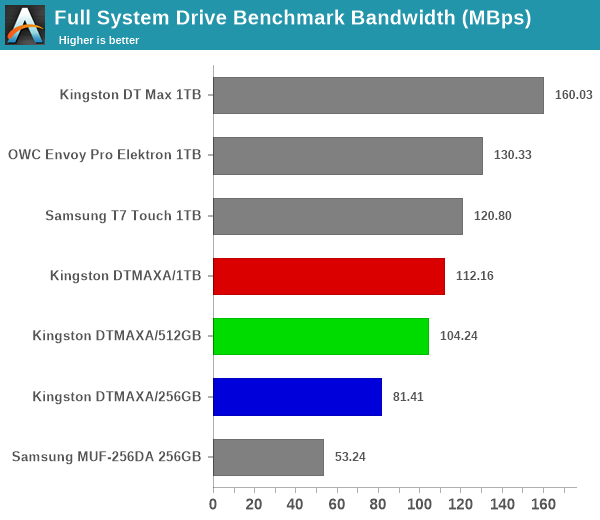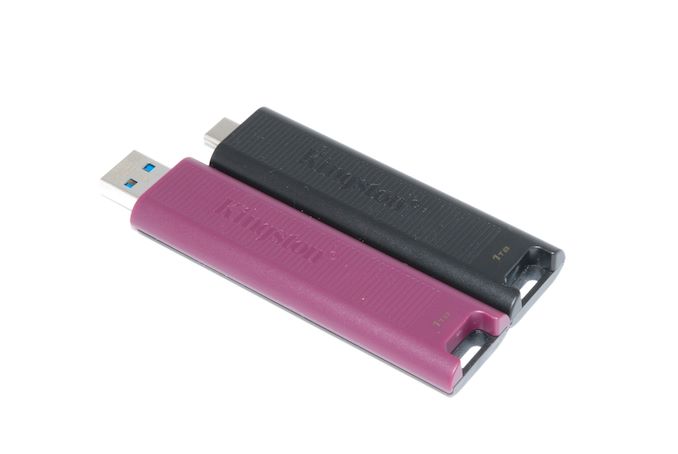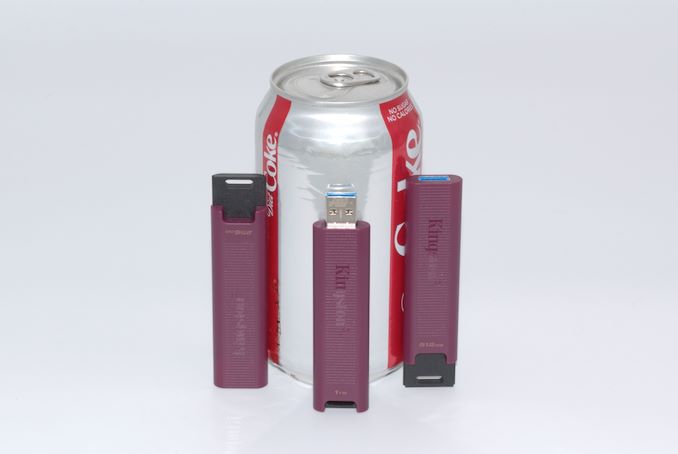
Kingston's new products in the portable flash-based external storage space have met with good market reception over the last year or so. Two products in particular - the Kingston XS2000 and the DataTraveler Max - continue to remain unique in the market with no other comparable products being widely available.
The XS2000 remains the only portable SSD with a USB 3.2 Gen 2x2 (20Gbps) interface equipped with a native flash controller (that brings cost and power-efficiency benefits over bridge-based solutions). The Kingston DataTraveler Max USB flash drive (UFD) - another product with a native flash controller - was introduced in August 2021. It advertised 1GBps-class speeds, low power consumption, and a Type-C interface - all in a thumb drive form-factor. Today, Kingston is expanding the DT Max series with three new drives - all sporting a USB 3.2 Gen 2 Type-A interface.
This review digs into all the three capacity points - 256GB, 512GB, and 1TB - in the new DTMAXA series sampled by Kingston. We'll be taking a look at the performance, power efficiency, and value proposition of the DTMAXA. We've also cracked the drive open in order to determine differences between the hardware in the original DT Max and the new DTMAXA products.
Bus-powered external storage devices have grown both in storage capacity and speeds over the last decade. Thanks to rapid advancements in flash technology (including the advent of 3D NAND and NVMe) as well as faster host interfaces (such as Thunderbolt 3 and USB 3.2 Gen 2x2), the market has seen the introduction of palm-sized flash-based storage devices capable of delivering 2GBps+ speeds.
The thumb drive form factor is attractive for multiple reasons - there is no separate cable to carry around, and the casing can be designed to include a keyring loop for portability. Vendors such as Corsair and Mushkin briefly experimented with SATA SSDs behind a USB bridge chip, but the thermal solution and size made the UFDs slightly unwieldy. The introduction of high-performance native UFD controllers last year from Phison and Silicon Motion has made this category viable again.
Kingston's DT Max series retains the traditional DataTraveler thumb drive form-factor. However, it takes full advantage of the USB 3.2 Gen 2 connector by promising 1GBps speeds. Available in three capacities - 256GB, 512GB, and 1TB, and in both Type-C and Type-A connector versions, Kingston says that they can deliver those high speeds across all six SKUs. We had done a thorough investigation into the 1TB capacity point of the DT Max Type-C version last year. Kingston claims that the new Type-A additions to the DT Max series are the same as the corresponding Type-C ones in terms of performance, capacity, and form factor, except for minor changes to the color and Type-A connector. We set out to confirm those claims.
The new Type-A series shares the same sliding cap design to protect the connector. The blue LED power indicator and keyring loop are retained. The new connector makes it necessary to slightly lengthen the UFD and also adds a couple of grams to the weight - specifics in the table at the end of this section.
The teardown process was similar to that of the Type-C version. With no screws in the design, everything is held by small plastic tabs. Other than the connector change, the only difference we could spot on the board was the updated flash package part number. While last year's Type-C version used the FPxxx08UCM1-7D (with Micron's 96L 3D TLC), the new DTMAX series uses the FBxxx08UCT1-AF (with Toshiba's BiCS5 112L 3D TLC). It is not clear whether newer production runs of the Type-C versions have also shifted the flash parts - we can only comment on our review samples. Kingston continues to retain the Silicon Motion SM2320 native UFD controller.
Since the publication of our DataTraveler Max Type-C review, we have processed a number of different drives with our updated testbed and test suite. For comparison purposes, we have chosen a number of 1TB and smaller-sized direct-attached storage (DAS) devices.
CrystalDiskInfo provides a quick overview of the capabilities of the internal storage device. Since the program handles each bridge chip / controller differently, and the SM2320 has not yet found its way into the tracked controllers, many of the entries are marked as vendor-specific, and some of the capabilities (such as the interface) are deciphered incorrectly. The temperature monitoring worked well, though - just like it did for the Type-C version.
| Comparative Direct-Attached Storage Devices Configuration | ||
| Aspect | ||
| Downstream Port | Native Flash | Native Flash |
| Upstream Port | USB 3.2 Gen 2 Type-A (Male) | USB 3.2 Gen 2 Type-C (Male) |
| Bridge Chip | Silicon Motion SM2320 | Silicon Motion SM2320 |
| Power | Bus Powered | Bus Powered |
| Use Case | 1GBps-class, compact USB thumb drive with retractable cover for Type-A connector | 1GBps-class, compact USB thumb drive with retractable cover for Type-C connector |
| Physical Dimensions | 91.2 mm x 22.3 mm x 9.5 mm | 82.6 mm x 22.3 mm x 9.5 mm |
| Weight | 14.5 grams | 12.5 grams |
| Cable | N/A | N/A |
| S.M.A.R.T Passthrough | Yes | Yes |
| UASP Support | Yes | Yes |
| TRIM Passthrough | Yes | Yes |
| Hardware Encryption | Not Available | Not Available |
| Evaluated Storage | Toshiba BiCS5 112L 3D TLC | Micron 96L 3D TLC |
| Price | USD 180 | USD 180 |
| Review Link | Kingston DTMAXA/1TB Review | Kingston DT Max 1TB Review |
Prior to looking at the benchmark numbers, power consumption, and thermal solution effectiveness, a description of the testbed setup and evaluation methodology is provided.
Testbed Setup and Evaluation Methodology
Direct-attached storage devices (including thumb drives) are evaluated using the Quartz Canyon NUC (essentially, the Xeon / ECC version of the Ghost Canyon NUC) configured with 2x 16GB DDR4-2667 ECC SODIMMs and a PCIe 3.0 x4 NVMe SSD - the IM2P33E8 1TB from ADATA.
The most attractive aspect of the Quartz Canyon NUC is the presence of two PCIe slots (electrically, x16 and x4) for add-in cards. In the absence of a discrete GPU - for which there is no need in a DAS testbed - both slots are available. In fact, we also added a spare SanDisk Extreme PRO M.2 NVMe SSD to the CPU direct-attached M.2 22110 slot in the baseboard in order to avoid DMI bottlenecks when evaluating Thunderbolt 3 devices. This still allows for two add-in cards operating at x8 (x16 electrical) and x4 (x4 electrical). Since the Quartz Canyon NUC doesn't have a native USB 3.2 Gen 2x2 port, Silverstone's SST-ECU06 add-in card was installed in the x4 slot. All non-Thunderbolt devices are tested using the Type-C port enabled by the SST-ECU06.
The specifications of the testbed are summarized in the table below:
| The 2021 AnandTech DAS Testbed Configuration | |
| System | Intel Quartz Canyon NUC9vXQNX |
| CPU | Intel Xeon E-2286M |
| Memory | ADATA Industrial AD4B3200716G22 32 GB (2x 16GB) DDR4-3200 ECC @ 22-22-22-52 |
| OS Drive | ADATA Industrial IM2P33E8 NVMe 1TB |
| Secondary Drive | SanDisk Extreme PRO M.2 NVMe 3D SSD 1TB |
| Add-on Card | SilverStone Tek SST-ECU06 USB 3.2 Gen 2x2 Type-C Host |
| OS | Windows 10 Enterprise x64 (21H1) |
| Thanks to ADATA, Intel, and SilverStone Tek for the build components | |
The testbed hardware is only one segment of the evaluation. Over the last few years, the typical direct-attached storage workloads for memory cards have also evolved. High bit-rate 4K videos at 60fps have become quite common, and 8K videos are starting to make an appearance. Game install sizes have also grown steadily even in portable game consoles, thanks to high resolution textures and artwork. Keeping these in mind, our evaluation scheme for portable SSDs and UFDs involves multiple workloads which are described in detail in the corresponding sections.
- Synthetic workloads using CrystalDiskMark and ATTO
- Real-world access traces using PCMark 10's storage benchmark
- Custom robocopy workloads reflective of typical DAS usage
- Sequential write stress test
In the next section, we have an overview of the performance of the Kingston DTMAXA drives in these benchmarks. Prior to providing concluding remarks, we have some observations on the UFD's power consumption numbers and thermal solution also.
Benchmarks such as ATTO and CrystalDiskMark provide a quick look at the performance of the direct-attached storage device. The results translate to the instantaneous performance numbers that consumers can expect for specific workloads, but do not account for changes in behavior when the unit is subject to long-term conditioning and/or thermal throttling. Yet another use of these synthetic benchmarks is the ability to gather information regarding support for specific storage device features that affect performance.
Synthetic Benchmarks - ATTO and CrystalDiskMark
Kingston claims read and write speeds of 1000 MBps and 900 MBps respectively for the DTMAX series. While the 1TB DTMax Type-C managed to hit that in the ATTO benchmarks, our chosen workloads don't see the DTMAXA SKUs hitting it - not even in the 1TB version. Writes top out around 650 MBps, while the reads do go close to 1000 MBps. ATTO benchmarking is restricted to a single configuration in terms of queue depth, and is only representative of a small sub-set of real-world workloads. It does allow the visualization of change in transfer rates as the I/O size changes. Even though screenshots are not shown here, setting the ATTO benchmark's queue depth to 8 (instead of the 4 we usually use) allows the numbers in the graph to go beyond even Kingston's advertised claims. That said, it is evident that the DT Max Type-C 1TB we evaluated last year is not exactly the same performance-wise as the new DTMAXA/1TB.

As expected, the DTMAXA series lands in the middle of the pack, with the 1TB outperforming the 512GB, and that in turn outperforms the 256GB SKU. The Type-C UFD emerges as the leader despite the presence of a couple of bridge-based SSD solutions in the mix. The new Type-A version is behind those, though
The performance of the UFDs and PSSDs in various real-world access traces as well as synthetic workloads was brought out in the preceding sections. We also looked at the performance consistency for these cases. Power users may also be interested in performance consistency under worst-case conditions, as well as UFD power consumption. The latter is also important when used with battery powered devices such as notebooks and smartphones. Pricing is also an important aspect. We analyze each of these in detail below.
Worst-Case Performance Consistency
Flash-based storage devices tend to slow down in unpredictable ways when subject to a large number of small-sized random writes. Many benchmarks use that scheme to pre-condition devices prior to the actual testing in order to get a worst-case representative number. Fortunately, such workloads are uncommon for direct-attached storage devices, where workloads are largely sequential in nature. Use of SLC caching as well as firmware caps to prevent overheating may cause drop in write speeds when a flash-based DAS device is subject to sustained sequential writes.
Our Sequential Writes Performance Consistency Test configures the device as a raw physical disk (after deleting configured volumes). A fio workload is set up to write sequential data to the raw drive with a block size of 128K and iodepth of 32 to cover 90% of the drive capacity. The internal temperature is recorded at either end of the workload, while the instantaneous write data rate and cumulative total write data amount are recorded at 1-second intervals.
| CrystalDiskMark Workloads - Power Consumption | |
| TOP: | BOTTOM: |
 |
|
 |
|
The Type-A version idles at around 0.7W (but does possess deep-sleep characteristics). The peak power is 2.31W, compared to the idling / peak of 0.8W / 3.05W for the Type-C version.
Final Words
The Kingston DTMAXA SKUs are available for purchase today. The official prices are $180 for the 1TB, $106 for the 512GB, and $63 for the 256GB SKU. At these prices, the main competition is the OWC Envoy Pro Mini, priced at $179, $109, and $79 for the three corresponding capacities. The OWC product is made of aluminum, and sports both Type-A and Type-C connectors in the same SKU with a bit of ingenious industrial design. Dimensions are similar (slightly shorter length, but thicker), but the weight is almost doubled (one might argue that it lends it extra solidity). One of my complaints about the DT Max Type-C UFD after using it on and off is that it is too flimsy. The new DTMAXA is not fragile to that extent, but users would do well to handle the UFD with care (something that appears to be a bit less of a concern with the OWC Envoy Pro Mini). The performance numbers claimed by OWC are the same as that of the DT Max series. Given these aspects, to price the drives similarly would not make much sense. Thankfully, the street pricing seems to be a bit more sane, with CDW making the three SKUs available for $137, $80, and $47 respectively. At these prices, there is not much competition, and the DataTraveler Max series becomes much more easier to recommend.
The Kingston DataTraveler Max has enjoyed pole position in this market segment, with no competitor in sight for a few quarters now. As the situation is about to change, Kingston's introduction of the Type-A SKUs will help in expanding the appeal of this high-performance product line. Though Kingston's claims of the new Type-A drives having the same performance as last year's Type-C drives (and thereby retaining the NVMe performance moniker) is not entirely false, last year's Type-C version still delivers better real-world performance. The new behavior also makes the lack of a thermal solution less of an issue.
While the 512GB and 1TB SKUs perform as well as any portable SSD, the lowest capacity SKU (256GB) is fit for sparing use only - if the plan is to subject it to heavy workloads, the lower-priced Samsung MUF-256DA is a better bet despite its USB 3.2 Gen 1 interface (it can sustain 100 MBps under extreme load, compared to around 50 MBps for the DTMAXA/256GB).
The new DTMAXA series does fill in the market gap (a Type-A flash drive that can saturate the interface, similar to a portable SSD). With Type-C and Type-A USB ports set to co-exist in the market for many years to come, a dual-connector (Type-C + Type-A) version could be more appealing to power users dealing with multiple PCs simultaneously. We hope Kingston builds upon this platform and creates rugged UFDs as well to appeal to a broader audience.
"type" - Google News
July 11, 2022 at 09:08PM
https://ift.tt/Qkz9NOq
Kingston DataTraveler Max UFD Series Review: New Type-A Thumb Drive Retains NVMe Performance - AnandTech
"type" - Google News
https://ift.tt/Xz2pEMY
https://ift.tt/YcGSAKQ
Bagikan Berita Ini
























0 Response to "Kingston DataTraveler Max UFD Series Review: New Type-A Thumb Drive Retains NVMe Performance - AnandTech"
Post a Comment